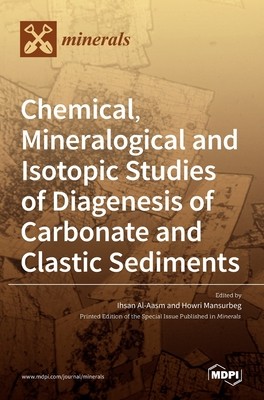
- We will send in 10–14 business days.
- Publisher: MDPI AG
- ISBN-10: 3036500782
- ISBN-13: 9783036500782
- Format: 17 x 24.4 x 1.9 cm, kieti viršeliai
- Language: English
- SAVE -10% with code: EXTRA
Chemical, Mineralogical and Isotopic Studies of Diagenesis of Carbonate and Clastic Sediments (e-book) (used book) | bookbook.eu
Reviews
Description
Diagenesis of carbonates and clastic sediments encompasses the biochemical, mechanical, and chemical changes that occur in sediments subsequent to deposition and prior to low-grade metamorphism. These parameters which, to a large extent, control diagenesis in carbonates and clastic sediments include primary composition of the sediments, depositional facies, pore water chemistry, burial-thermal and tectonic evolution of the basin, and paleo-climatic conditions. Diagenetic processes involve widespread chemical, mineralogical, and isotopic modifications affected by the original mineralogy of carbonate and clastic sediments. These diagenetic alterations will impose a major control on porosity and permeability and hence on hydrocarbon reservoirs, water aquifers, and the presence of other important economic minerals. In this Special Issue, we have submissions focusing on understanding the interplay between the mineralogical and chemical changes in carbonates and clastic sediments and the diagenetic processes, fluid flow, tectonics, and mineral reactions at variable scales and environments from a verity of sedimentary basins. Quantitative analyses of diagenetic reactions in these sediments using a variety of techniques are essential for understanding the pathways of these reactions in different diagenetic environments.
EXTRA 10 % discount with code: EXTRA
The promotion ends in 23d.19:06:55
The discount code is valid when purchasing from 10 €. Discounts do not stack.
- Publisher: MDPI AG
- ISBN-10: 3036500782
- ISBN-13: 9783036500782
- Format: 17 x 24.4 x 1.9 cm, kieti viršeliai
- Language: English English
Diagenesis of carbonates and clastic sediments encompasses the biochemical, mechanical, and chemical changes that occur in sediments subsequent to deposition and prior to low-grade metamorphism. These parameters which, to a large extent, control diagenesis in carbonates and clastic sediments include primary composition of the sediments, depositional facies, pore water chemistry, burial-thermal and tectonic evolution of the basin, and paleo-climatic conditions. Diagenetic processes involve widespread chemical, mineralogical, and isotopic modifications affected by the original mineralogy of carbonate and clastic sediments. These diagenetic alterations will impose a major control on porosity and permeability and hence on hydrocarbon reservoirs, water aquifers, and the presence of other important economic minerals. In this Special Issue, we have submissions focusing on understanding the interplay between the mineralogical and chemical changes in carbonates and clastic sediments and the diagenetic processes, fluid flow, tectonics, and mineral reactions at variable scales and environments from a verity of sedimentary basins. Quantitative analyses of diagenetic reactions in these sediments using a variety of techniques are essential for understanding the pathways of these reactions in different diagenetic environments.


Reviews